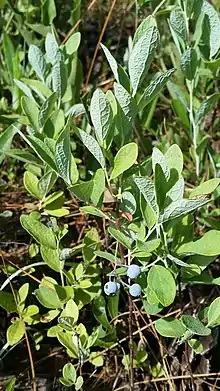| Dwarf dangleberry | |
|---|---|
 | |
| Scientific classification | |
| Kingdom: | Plantae |
| Clade: | Tracheophytes |
| Clade: | Angiosperms |
| Clade: | Eudicots |
| Clade: | Asterids |
| Order: | Ericales |
| Family: | Ericaceae |
| Genus: | Gaylussacia |
| Species: | G. nana |
| Binomial name | |
| Gaylussacia nana (A. Gray) Small | |
| Synonyms[1][2] | |
| |
Gaylussacia nana, the dwarf dangleberry or Confederate huckleberry, is a plant species native to the coastal plains of the southeastern United States. It has been reported from Louisiana, Alabama, Mississippi, Georgia, Florida, North Carolina and South Carolina.[3] It is found in either wet or dry soil, in woodlands, bogs, sandy ridges and savannahs, usually at elevations less than 100 m (330 feet).[4]
Gaylussacia nana is a shrub up to 1 m (40 inches) tall, sometimes forming large colonies of hundreds of individuals. It has dull green to yellow-green leaves up to 4 cm (1.6 inches) long. Inflorescences hang from the leaf axils or from the tips of branches, with 1-4 greenish-white flowers. Fruits are sweet and juicy, usually dark blue but sometimes white, up to 8 mm (0.3 inches) in diameter.[5][6]
References
- ↑ Tropicos
- ↑ The Plant List
- ↑ Biota of North America Program 2014 county distribution map
- ↑ Flora of North America Gaylussacia nana (A. Gray) Small, 1897. Dwarf dangleberry
- ↑ Small, John Kunkel. Bulletin of the Torrey Botanical Club 24(9): 443. 1897.
- ↑ Small, John Kunkel. Manual of the Southeastern Flora 1008, 1506. 1933.